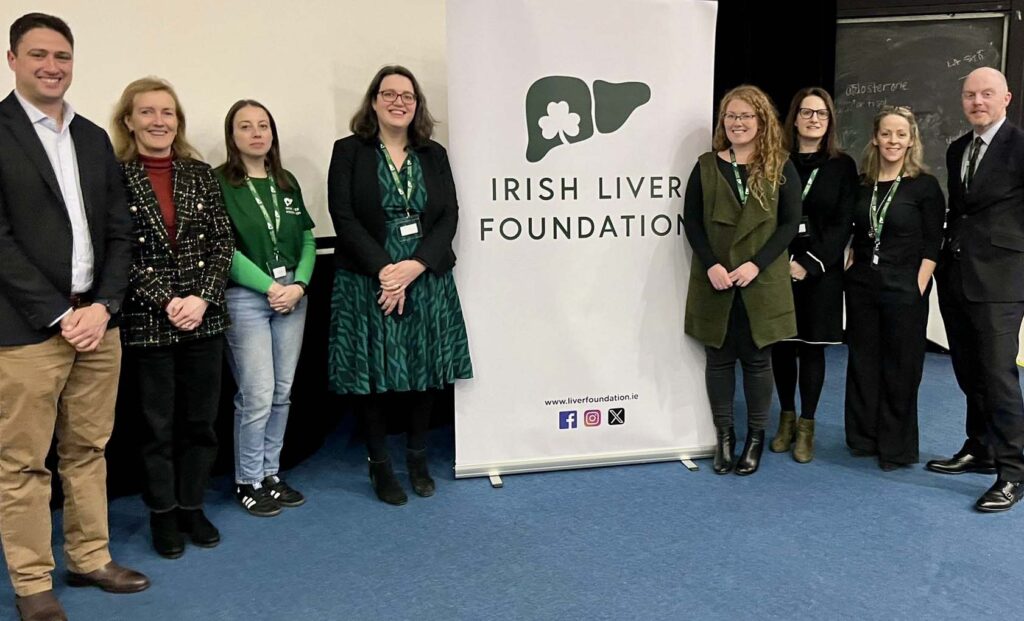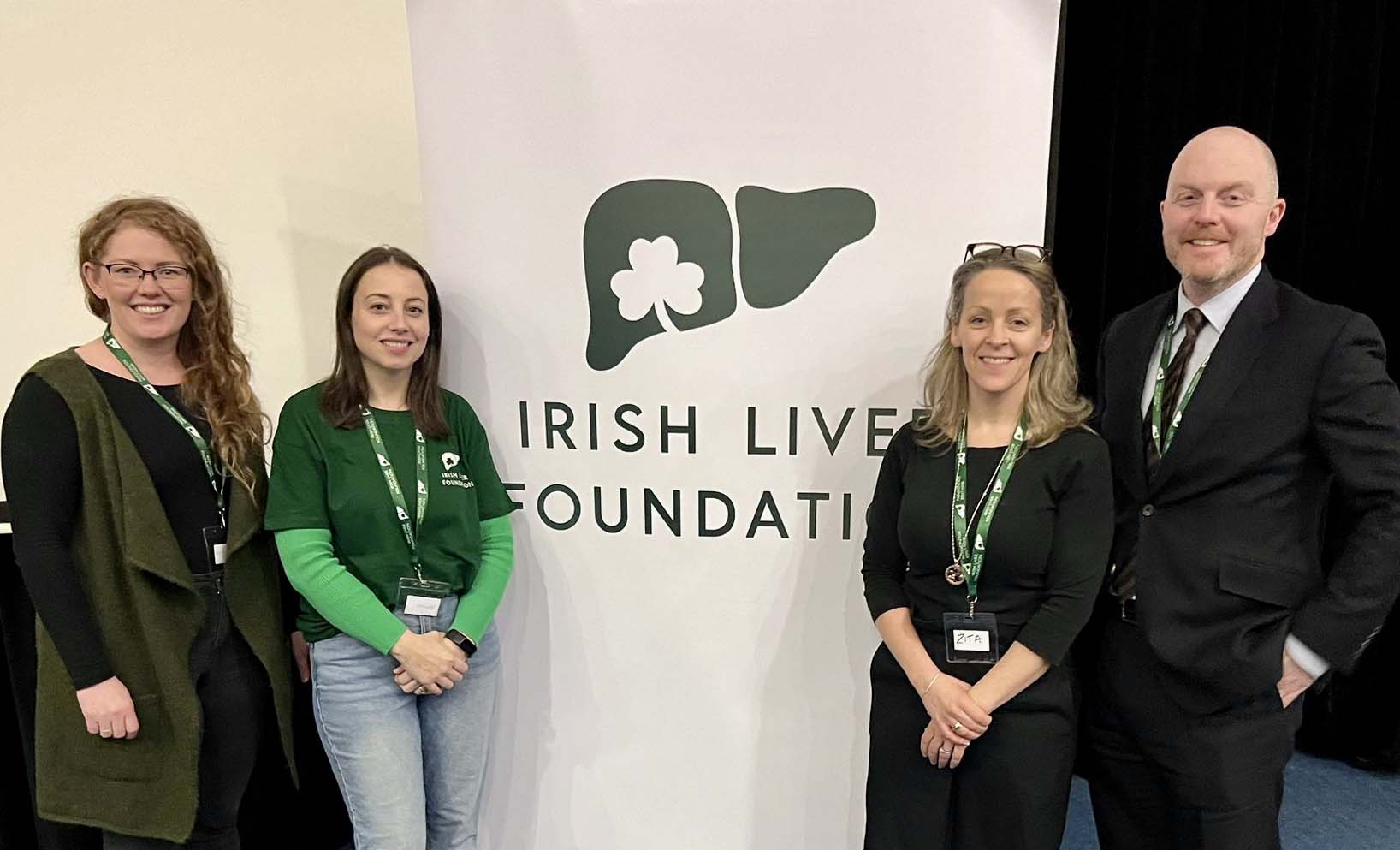A meeting overview report of the first annual Irish Liver Foundation Study Day, which took place in
the RCSI, Dublin, on 21 January
The first annual Irish Liver Foundation Study Day, organised by the newly founded Irish Liver Foundation, took place on Saturday, 21 January. There were 140 attendees who came from all over the country to see a well-rounded line-up of leading expert speakers currently working in liver health in Ireland. Four CPD points were awarded for attendance.
The Irish Liver Foundation was launched in December 2022 and since then has been going from strength to strength. The study day came about when founding members Prof John Ryan, Dr Zita Galvin, and Prof Steve Stewart wanted not only to showcase the exceptional work of those working in the area of liver health, but highlight the most up-to-date care, treatments, and management of liver disease.
Alcohol-related liver disease
Dr Audrey Dillon, Consultant Hepatologist in St Vincent’s University Hospital (SVUH), Dublin, gave an overview of alcohol-related liver disease. Her opening line was simple – “words matter”, and that there is a need to familiarise ourselves with the appropriate terminology when speaking about alcohol and liver disease. No longer is ‘alcoholic’ accepted in our nomenclature and terms like alcohol use disorder (AUD), alcohol-related liver disease (ARLD), or alcohol-associated hepatitis (AAH) are more preferred. Furthermore, Dr Dillon provided expert tips on how we can enhance our patient contact with tools like the AUDIT-C questionnaire, where we can clearly demonstrate to patients how potentially harmful their alcohol consumption is. Dr Dillon presented recent evidence that showed how abstinence from alcohol improves prognosis across all stages of portal hypertension in alcohol-related cirrhosis. So, it is never too late for patients to give up alcohol. There is a myriad of supports available to help patients establish and maintain abstinence, including pharmacological aids like acamprosate, naltrexone, and baclofen, to name a few. The takeaway message was stigma matters. We need to have open and non-judgemental conversations that lean towards a positive outlook. Clinicians should be more open to prescribing medications to support abstinence. We should also reiterate to all patients who have cirrhosis that they should be abstinent, regardless of their cause of cirrhosis. Considering liver transplant in all sick patients with ARLD is important.
MASLD
Prof Orla Crosbie, Consultant Hepatologist, Cork University Hospital, and current President of the Irish Society of Gastroenterology, gave a wonderful presentation on metabolic-associated steatotic liver disease (MASLD). MASLD is another example of how words and terminology are constantly evolving in hepatology. Previously known as non-alcoholic fatty liver disease (NAFLD) and non-alcoholic steatohepatitis (NASH), both conditions were more of a diagnosis of exclusion. MASLD is now the preferred nomenclature as it focuses on the dysfunction of metabolism rather than just exclude alcohol as a cause of steatosis. Current non-invasive tests were examined and, while most are convenient, follow algorithms, and can be used in combination with other tests, there still needs to be caution when interpreting these as they can be impacted by the skill of the technician, etc (eg, FibroScan).
Therapies for MASLD involve three key areas – weight loss, lifestyle, and bariatric/endoscopy intervention. There are now more pharmaceutical options, including thyroid hormone receptor β agonists (THR-β) or glucagon-like peptide-1 receptor agonists (GLP-1), to help patients on their weight loss journey. Evidence was presented that showed with 5 per cent weight loss, hepatic steatosis will regress. A 7 per cent weight loss will lead to resolution of steatohepatitis. A 10 per cent weight loss demonstrated fibrosis regression in 80 per cent of patients. The future is much brighter for patients with MASLD.
Diet and liver disease
Prof Audrey Tierney, Discipline Lead In Human Nutrition and Dietetics, Health Research Institute in University of Limerick, presented on diet and liver disease. Data put forward on the most recent Irish food consumption trends (National Adult Nutrition Survey II) showed that we are not eating enough dairy, fruits, and vegetables. ‘Western diets’ that are rich in processed foods, red meat, dairy, and low intake of fruits and vegetables are linked with a 56 per cent increased risk for hepatic steatosis. Diets, including the Mediterranean diet, that contain high levels of fruits, vegetables, white meat, olive oil and fibre are linked with a decreased risk of steatosis (approximately -22 per cent). So, the big question on the day was, what is the Mediterranean diet and how can we help patients incorporate it into their lifestyle? Prof Tierney’s answer was simple…. The 10 commandments of the Mediterranean diet:
1. Using extra virgin olive oil as the main added fat.
2. Have vegetables/salads with every meal.
3. Eat legumes twice per week.
4. Eat seafood/fish twice per week.
5. Have meat/chicken less often and in smaller portions.
6. Choose wholegrain sourdough breads.
7. Have fresh fruit every day.
8. Have a handful of unsalted nuts every day.
9. Have fermented dairy daily ‘yoghurt’.
10. If consuming wine, drink when eating a meal and in small amounts.
While this was very practical and helpful advice, Prof Tierney was quick to explain that there were several barriers to patients following such a diet. Affordability, palatability, and a general understanding of the importance of nutrition were identified as major difficulties. The key take home message? Dietitians play a pivotal role in liver health and we should strive to have them as a standard player in all liver units. Furthermore, as clinicians, we should familiarise ourselves more with the Mediterranean diet and encourage it as much as possible.
Haemochromatosis
Prof John Ryan presented an overview on haemochromatosis (HH) in Ireland. Prof Ryan is a Consultant Hepatologist in Beaumont Hospital and co-founder/Director of the Irish Liver Foundation. HH has many nuances; in particular Prof Ryan highlighted the implications of those who are C282Y homozygous for the HFE gene. Those individuals have a much higher risk for developing a liver malignancy in the setting of cirrhosis, an important factor to bear in mind when screening for liver cancer. Globally, Ireland has more people diagnosed with HFE per capita than any other.
Prof Ryan described the three elements to ‘de-ironing’. Firstly, diet and lifestyle changes. The Irish Haemochromatosis Association have produced a wonderful document on diet which should be a staple booklet in all liver units. Reducing the amount of excess dietary iron can be achieved by reducing consumption of red meat and avoiding taking vitamin C supplements. Venesection is a first-line treatment for HFE. The induction phase calls for venesection weekly or fortnightly. Checking haemoglobin (Hb) ahead of each phlebotomy is important, as a Hb of <11 will mean pausing treatment. There are guidelines for venesection which aim for a target ferritin of approximately 50µg/L in the induction phase. During the maintenance phase, the frequency for venesection will be varied, usually two-to-six phlebotomies per year. Hb is checked prior to each phlebotomy and ferritin and transferrin saturation checked every six months. Target ferritin, during maintenance, is 50-to-100µg/L. Lifelong follow-up is required. Those requiring venesection can also donate blood at donation clinics thus not requiring delays at hospitals where appointments may not be available at short notice. Standardisation of care through the National Clinical Programme for Gastroenterology and Hepatology will be crucial to enhancing patient experiences and reducing future morbidity and mortality associated with HH. The introduction of a HH registry and HH research programme in Ireland is required. Screening of at-risk individuals will be paramount in identifying those with HH early, therefore preventing unnecessary complications.
We should also reiterate to all patients who have cirrhosis that they should be abstinent regardless of their cause of cirrhosis. Considering liver transplant in all sick patients
with ARLD is important
Immune-mediated and cholestatic liver diseases
Dr Omar El-Sherif, Consultant Hepatologist, SVUH, took us on a journey through immune-mediated and cholestatic liver diseases. There were three main conditions presented, including auto immune hepatitis (AIH), primary biliary cholangitis (PBC), and primary sclerosing cholangitis (PSC).
AIH is a lifelong chronic condition that can have periods of relapsing and remitting with varied phenotypic presentations and can manifest at any age. There is no single diagnostic test, but a culmination of blood tests, scans, and liver biopsy are used. First-line treatment with corticosteroids ± azathioprine (AZA) is lifesaving. Optimum dosage for inducing remission is undetermined, but it is important to note that AZA is dosed based on weight; so always bear that in mind for prescribing. Referral to specialist centres is recommended, as not everyone responds to first-line therapies and more bespoke treatments may be needed. Liaison with a transplant centre is indicated in cases of acute severe fulminant presentations or those with advanced disease or decompensated liver disease.
February 29 was recognised as Rare Disease Day and PBC and PSC are acknowledged on this day. Important points in relation to PBC include that it is not always necessary to have a liver biopsy, but it is imperative that those on ursodeoxycholic acid are on the correct dose for their weight; and newer therapies are finally becoming available to completely change the treatment options for this condition. PSC can have really debilitating symptoms, particularly as 70-to-80 per cent of those diagnosed with PSC develop inflammatory bowel disease, Dr El-Sherif explained. In this cohort of patients, the risk of gallbladder, pancreatic, liver and colorectal cancer is significantly increased. The younger a person is when they are diagnosed with PSC, the more likely they are to have future complications. Yearly colonoscopies are recommended for this group of patients.
Managing compensated cirrhosis
The final presenter was Dr Zita Galvin, Consultant Hepatologist in SVUH, and co-founder of the Irish Liver Foundation. Dr Galvin gave a run down on managing a patient with compensated cirrhosis. Being able to manage compensated cirrhosis appropriately means patients are less likely to decompensate or at least have longer periods between these episodes. Keeping these patients well involves the input of specialist liver clinics. Providing patient education/information is key, which is one of the many functions of the Irish Liver Foundation.

Pictured L-R: Dr Omar El-Sherif, St Vincent’s University Hospital (SVUH); Prof Orla Crosbie, Cork University Hospital; Dr Audrey Dillon, SVUH; Dr Zita Galvin, SVUH; Prof Audrey Tierney, University Hospital Limerick; and Prof John Ryan, Beaumont Hospital and the RCSI
Variceal screening plays a vital role in helping to prevent major bleeding events. Those attending specialist liver clinics are usually offered screening every one-to-two years. The use of carvedilol was discussed and why it is now the recommended non-selective beta blocker as endorsed by the latest Baveno guidelines.
Screening for hepatocellular carcinoma (HCC) is a standard care practice (NICE guidelines), which involves ultrasound ± Alfa Feto-Protein (AFP) blood test every six months. The prevalence of HCC is increasing and the majority of those being diagnosed are at a much later stage in the disease than is aimed for. All HCC cases should be discussed at a specialist MDT. Those deemed not suitable for treatment should no longer be surveyed.
Osteoporosis screening is more important than ever in those with cirrhosis as they have an increased risk of limb fracture and almost double the risk for vertebral fractures. All patients should be advised on adequate calcium intake and ensuring appropriate levels of vitamin D.
Keeping updated with vaccinations is one area that GPs can be of immense support. Good nutrition and physical activity are always encouraged, and, of course, advice on complete abstinence from alcohol.
Good nutrition and physical activity are always encouraged, and, of course, advice on complete abstinence from alcohol
One area that Dr Galvin highlighted was the area of palliative care and liver disease. Acknowledging that it can be very difficult to determine accurate prognosis, it is well recognised that there is a place for palliation far earlier in the patient’s disease course. Community palliative care teams are more and more familiar with the complexities and nuances that come with those with decompensated liver disease. They are key in aiding and enhancing patients’ quality-of-life.
Finally, Dr Galvin concluded with, to my mind, the take home messages of the day:
1. Paracetamol is analgesia of choice.
a. In liver disease MAX 3g per day.
b. In decompensated disease MAX 2g per day.
2. Avoid NSAIDs.
3. Caution with opiates.
4. Avoid herbal remedies.
5. Avoid night sedation/anxiolytics where possible.
6. Lactulose is the preferred laxative.
7. For pruritis: Try Aveeno menthol, cholestyramine, rifampicin, naltrexone, bezafibrate, and sertraline.
8. Statins are not contraindicated and should be used in patients who have indications to.
9. Consider referral to palliative care sooner rather than later.
Author: Pauline Dillon, Hepatology CNS, Irish Liver Foundation Charity/Hepatology Unit, Beaumont Hospital, Dublin













Leave a Reply
You must be logged in to post a comment.